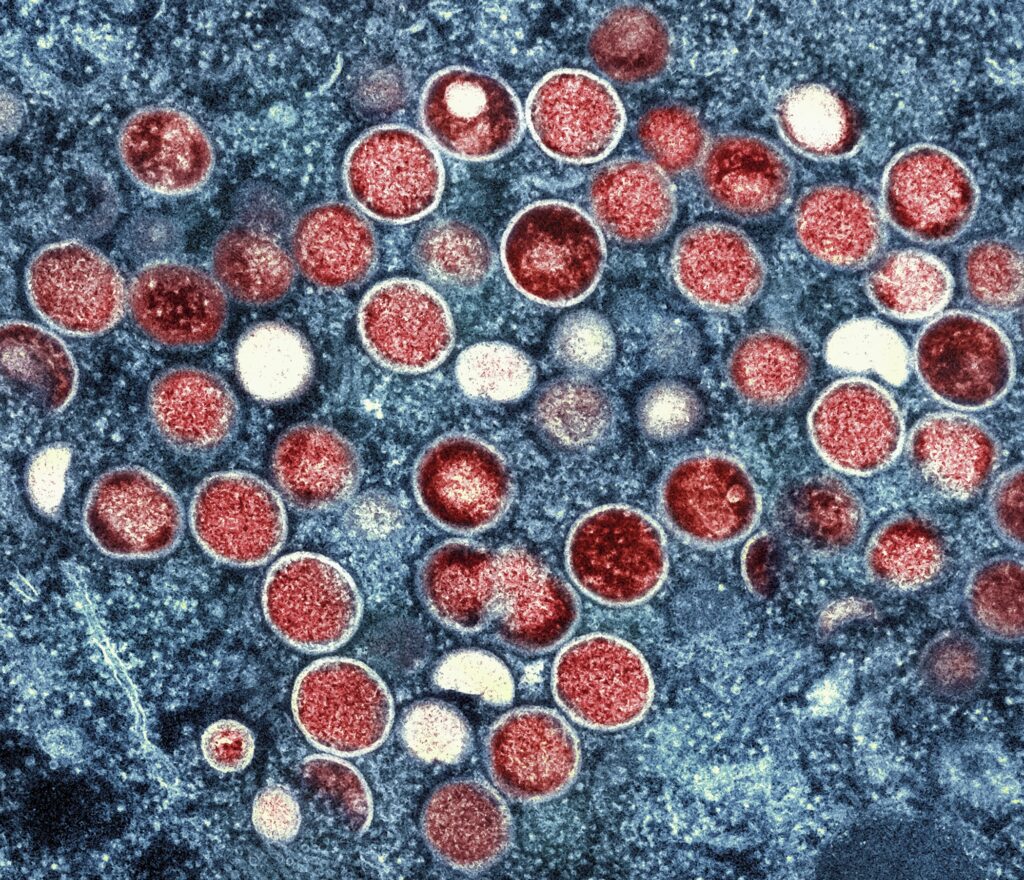Mpox or monkeypox explained: Causes, symptoms, how it spreads

FILE – This undated image provided by the National Institute of Allergy and Infectious Diseases shows a colorized transmission electron micrograph of monkeypox particles (red) found within an infected cell (blue), cultured in the laboratory that was captured and color-enhanced at the NIAID Integrated Research Facility in Fort Detrick, Md. (NIAID via AP, File)
CEBU CITY, Philippines – In a span of just a few days, several cases of the monkeypox virus, simply referred to as mpox, have been reported in various provinces in the Philippines.
The latest came from Iloilo where healthcare officials are monitoring a total of five patients, including one confirmed to have the infection.
In Mindanao, several areas including Cotabato and the Bangsamoro Autonomous Region of Muslim Mindanao (Barmm) recently observed increasing number of mpox patients.
Meanwhile in Luzon, Baguio City also recorded its first case of mpox infection on May 20.
READ: Iloilo logs 1 mpox case; 4 suspected cases under observation
So far here in Cebu, there are no reports of confirmed patients yet.
A now-deleted post on online aggregator platform Reddit claiming of a patient showing symptoms of the viral infection here in Cebu City recently went viral.
The Department of Health in Central Visayas (DOH-7) have yet to verify and issue statements on these reports.
These developments have also caused hysteria and panic on social media, with some netizens poking fun and drawing parallels with the Covid-19 pandemic.
To provide clarity, CDN Digital has compiled key facts the public should know, especially how to protect themselves from getting infected.
READ: All suspected Mpox cases in Mandaue City test negative
Monkeypox: Causes
According to the World Health Organization (WHO), monkeypox is caused by the virus Orthopoxvirus which belongs to the same family of virus responsible for the much deadlier and now-eradicated smallpox.
Researchers first identified mpox from a group of captive research African monkeys in 1958. Based on an entry from the John Hopkins University, these monkeys were also found in the tropical rainforests of Central and West African countries.
In 1972, scientists reported the first human case among individuals living at the edge of the rainforests, confirming it as a zoonotic disease which meant it can be transmitted from animals to humans.
Mpox virus has two types: Clade I which causes more severe illness and deaths, and Clade II that causes less severe infections.
The most recent global outbreak for mpox began in 2022, caused by Clade II.
Mpox in the Philippines
In the Philippines, the first mpox cases was logged just last year in Metro Manila. The 33-year-old patient, who had mild Clade II symptoms, had no history of travel abroad.
As of December 2024, the country logged a total of 52 mpox cases. There had been no fatalities so far.
Transmission, Symptoms, Recovery
Contrary to unverified and unreliable sources circulating online, mpox is not an airborne disease like Covid-19.
It can spread from person to person through close contact with an infected person such as:
- Skin-to-skin: Touching, hugging or sex
- Mouth-to-mouth or mouth-to-skin contact: Kissing
- Face-to-face with someone who has mpox: Talking or breathing close to one another, which can generate infectious respiratory particles.
An individual may also get the infection through indirect contact with contaminated surfaces like beddings, clothings, and linens, to name a few.
When infected, symptoms may start showing up between three to 17 days after exposure. The most common signs of mpox infection include:
- Skin rash
- Mucosal lesions with fever
- Swollen lymph nodes or sore throat
- Muscle aches and back pain
- Headache and low energy
- Sore throat
Vulnerable population
Generally, the Clade II of the mpox virus, which caused the 2022 global outbreak, has a high survival rate. In other words, an infected patient can recover within two to four weeks.
However, certain groups or population have greater risks of developing severe cases of mpox like:
- People with severely weakened immune systems
- Children younger than 1
- People with a history of eczema
- Pregnant persons
Treatment, vaccines, prevention
Treatment for mpox usually involve managing symptoms and supportive care as the infection resolves itself. This includes managing skin damage from the rash, maintaining hydration to ease digestion, and providing pain relief.
While other countries, like the United States, have started using mpox vaccines, the DOH and Food and Drug Administration (FDA) have yet to authorize the use of any mpox vaccines.
In the meantime, DOH advised the public to observe health protocol to protect themselves from getting infected such as:
- covering the mouth when sneezing or coughing
- maintaining good ventilation or airflow
- frequent washing of hands with soap
- avoid contact with individuals showing symptoms of the infection.
Sources
- Mpox – World Health Organization
- Mpox – John Hopkins University
- Expert: Here’s What to Know About the MPox Outbreak Emergency – University of California San Francisco
- Mpox: What is it, how it spreads, care for patients – Inquirer
Disclaimer: The comments uploaded on this site do not necessarily represent or reflect the views of management and owner of Cebudailynews. We reserve the right to exclude comments that we deem to be inconsistent with our editorial standards.
